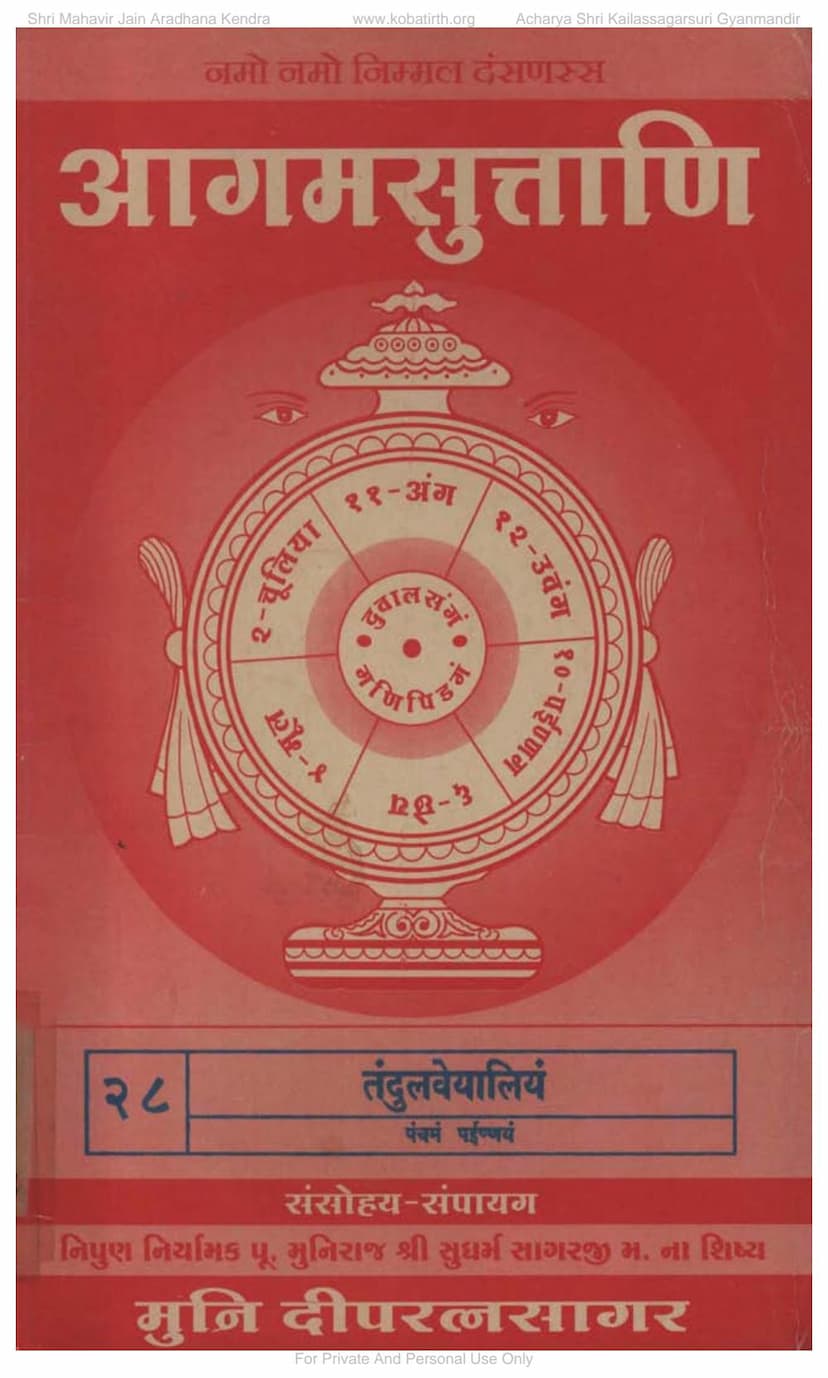Agam 28 Tandulveyaliyam Painnagsutt 05 Moolam
Added to library: September 1, 2025

Summary
This document is a digitized version of Agam 28, Tandulveyaliyam Painnagsutt 05 Moolam, a Jain text. The publication is from Agam Shrut Prakashan and authored by Dipratnasagar and Deepratnasagar.
Here's a breakdown of the content based on the provided pages:
General Information & Acknowledgements (Pages 1-6):
- Title and Author: Clearly states the book title "Tandulveyaliyam" (Tandulveyaliya) and identifies it as the fifth "Painnagsutt" (Painnagam). The authors are listed as Muni Dipratnasagar and Muni Deepratnasagar.
- Publisher and Institution: Published by Agam Shrut Prakashan and associated with Shri Mahavir Jain Aradhana Kendra and Acharya Shri Kailassagarsuri Gyanmandir.
- Dedication: The text is dedicated to various Jain acharyas and spiritual guides, showing reverence within the tradition.
- Financial Support: A significant portion of the initial pages (Pages 3-5) is dedicated to listing numerous donors who contributed financially to the publication of the 45 Agams set and this specific text. These donors are from various locations, indicating a widespread appreciation and support for Jain scripture preservation.
- Content Structure and Index: Page 6 provides a detailed index or table of contents for the "Tandulveyaliyam" text. It outlines the structure with chapter numbers, scriptural references (Sutamko, Gahamko), and potentially references to commentaries or translations (English numbering for Vritti). This suggests a structured and scholarly approach to the text.
- Instructional Notes: Page 6 also includes notes on how to interpret the numbering system used in the publication, indicating that it connects to other Jain scriptural indices.
The Text Itself - Tandulveyaliyam (Pages 7-22):
- Introduction: The text begins with salutations and an introduction to the Tandulveyaliyam, mentioning its purpose and the teachings of Lord Mahavir.
- Core Content - Fetal Development and Life Sciences: The bulk of the content focuses on detailed descriptions of:
- Conception and Gestation: It describes the process of conception, the development of the fetus within the womb, the formation of various bodily parts, senses, and organs month by month.
- Bodily Constitution: It discusses the origin of different bodily components, distinguishing between those derived from the mother and the father (e.g., flesh, blood, bones, hair).
- Life Stages and Lifespan: The text delves into the stages of human life, from infancy to old age, discussing the duration of life, physical and mental changes associated with aging, and the concept of karma influencing one's lifespan and rebirth.
- The Nature of the Body: A significant theme is the disaggregation of the human body, emphasizing its impermanent, impure, and ultimately transient nature. It uses vivid descriptions to highlight the repulsive aspects of the body, aiming to foster detachment and aversion to worldly pleasures.
- Metaphorical Language: The text employs metaphors and analogies to explain complex concepts, often comparing the body to impure substances and processes to discourage attachment.
- Spiritual Guidance: Interspersed with the biological and physiological descriptions are exhortations to practice virtue, detachment, and follow the teachings of the Jinas (enlightened beings) to achieve liberation. It stresses the importance of spiritual practice over worldly attachments.
- Life's Impermanence: The text repeatedly emphasizes the fleeting nature of life, youth, and worldly possessions, urging readers to engage in spiritual pursuits before it's too late.
- The Role of Karma: Karma is presented as the driving force behind one's birth, experiences, and destiny.
- Specific Details: It includes details about conception in different realms (hellish, heavenly), the process of birth, the quantity of food consumed (measured in "tanduls" or grains), and the composition of the body in terms of blood, semen, etc.
- Discussions on Purity and Impurity: A recurring theme is the emphasis on the inherent impurity of the physical body and its constituents, contrasting it with the purity of the soul and spiritual knowledge.
Concluding Remarks and Publication Information (Pages 22-26):
- Completion of Text: The final pages of the Tandulveyaliyam itself indicate its completion.
- List of Other Publications: Page 22 onwards provides a catalog of other publications by the same publisher, "Agam Shrut Prakashan," and related institutions. This showcases a broader effort to publish Jain scriptures.
- Agam Sutra Series: Pages 24 onwards lists the "Agam Sutrani" (Agam Sutras) by number, categorizing them into Anga Sutras, Upanga Sutras, and Painna Sutras. This positions the Tandulveyaliyam within the larger corpus of Jain Agamas.
- Appendices (Parishisht): Page 25 details the appendices (Parishisht) that accompany the 45 Agam set. These appendices include:
- Vishayanukramo (Subject Index): A comprehensive index of subjects.
- Vishisht Shabdhanukramo (Special Word Index): An alphabetical index of specialized words with references.
- Vishesh Namuanukramo (Special Name Index): An index of proper names.
- Gathanukramo (Verse Index): An index of verses.
- Sutranukramo (Sutra Index): An index of sutras.
In summary, Agam 28, Tandulveyaliyam Painnagsutt 05 Moolam, is a foundational Jain scripture that provides a detailed, albeit sometimes graphic, account of fetal development, the human body's composition, and the journey of the soul through life, death, and rebirth. It strongly emphasizes the impermanence and impurity of the physical form, encouraging readers to pursue spiritual liberation through virtuous conduct and detachment from worldly desires. The publication is a collaborative effort supported by numerous donors and highlights the Jain tradition's commitment to preserving and disseminating its sacred texts.